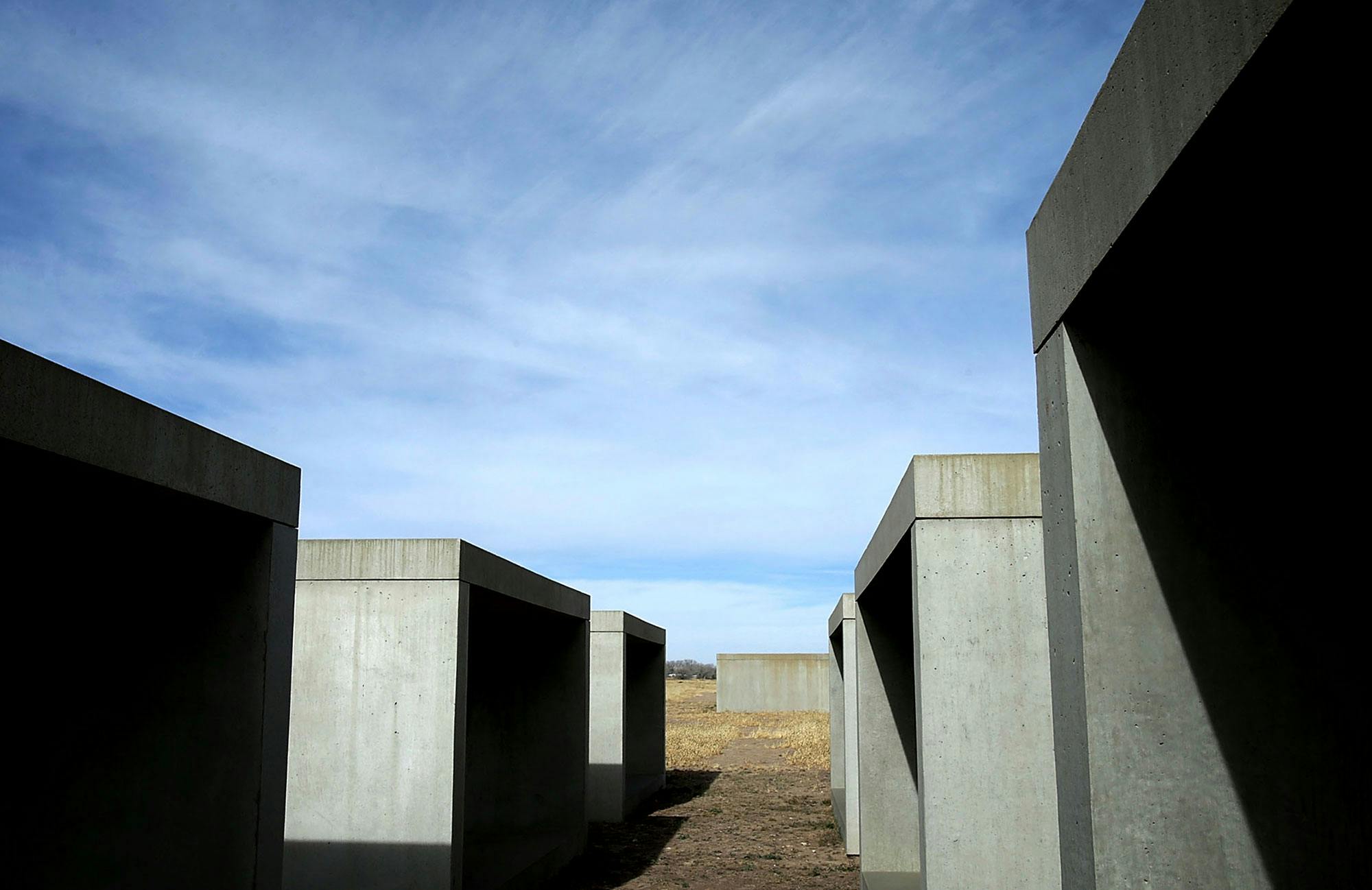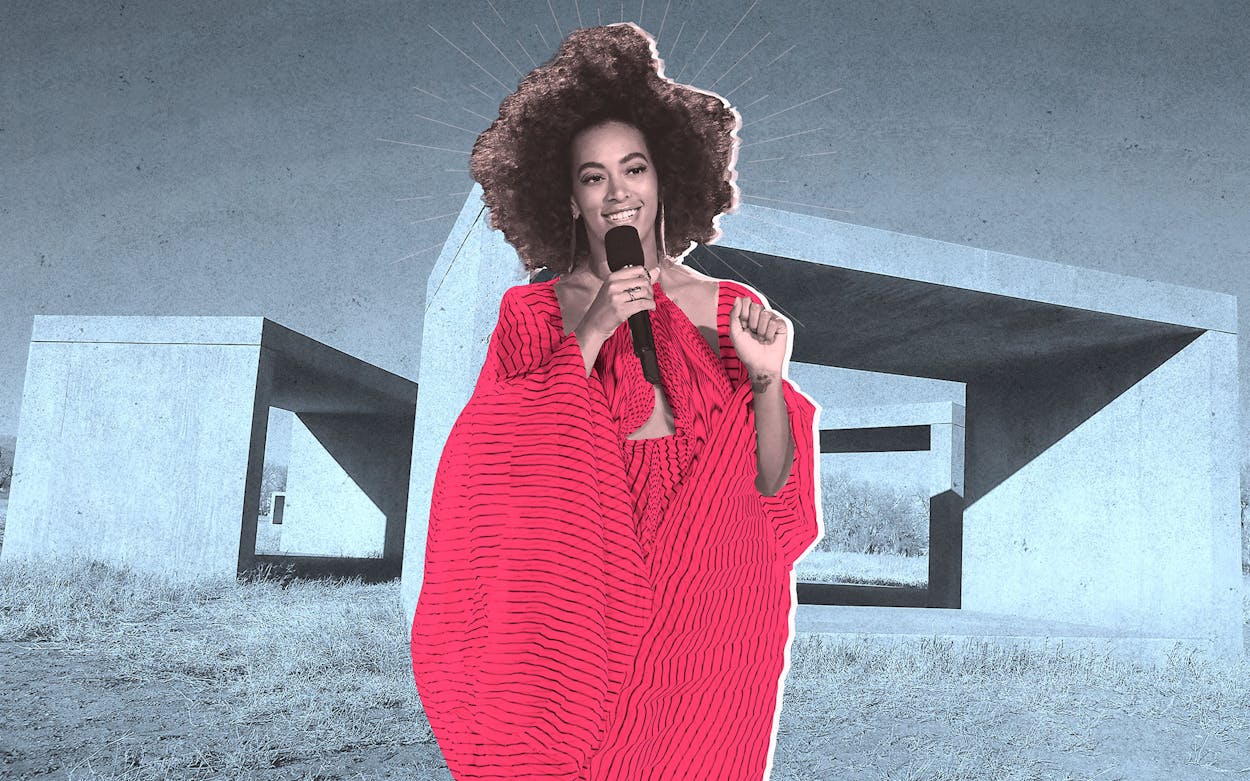Ever since Beyoncé posted pictures of her trip with Solange to Marfa in 2012, I’ve wanted to visit the small West Texas town, but I never quite had a good enough reason. With her performance of “Scales” at the Chinati Weekend on Sunday, Solange gave me one.
I’ve written before about how Solange’s latest album, A Seat at the Table, has moved and inspired me, and I’ve noticed through social media as Solange has adapted the album into performance pieces at the Menil Collection in Houston and the Guggenheim Museum in New York. In August, Solange announced that between her sets at both weekends of Austin City Limits, she would perform a “site specific version” of “Scales” alongside Donald Judd’s “15 untitled works in concrete,” and invited us to join her for the free performance. Her caption on the announcement said, “Texas peeps, pull up!”
After two months, one hastily bought white dress, and a six-and-a-half-hour drive from Austin, I finally pulled up to Marfa late Saturday evening with my friend Evelyn Ngugi. I spent early Sunday afternoon exploring the Chinati Foundation for the first time, where I could see how Donald Judd’s ideas influenced Solange. In her Instagram announcement, she wrote that his work has “had such profound influence on the way I view the world.” Walking among Judd’s “100 untitled works in mill aluminum” and “15 untitled works in concrete,” I could see how his ideas of minimalism and symmetry melding with nature and light had influenced Solange’s own work. Her use of shapes, color, and nature were consistent throughout every aspect of A Seat at the Table, from the booklet that accompanied the album to her music videos to her stage sets.
After briefly exploring the city, we donned our white, stowed our phones away (cell phones and photography were prohibited during the performance), and joined the ever-growing line of white-clad visitors. While waiting in line to enter the field that housed Judd’s “15 untitled works in concrete,” I talked with Maureen Nicol, the projects and operations lead for BossBabes ATX and a Ph.D student studying early childhood education at the University of Texas at Austin. She’d volunteered at the Chinati Foundation for the weekend, taking advantage of the opportunity to visit Marfa and Chinati Weekend for the first time and to see Solange perform. When I asked her what she expected from the performance, she was interested in how Solange would use the space at Chinati, which Nicol described as the most “open” museum she’d been to. She was also interested in the black people who’d made the journey to Chinati for Solange, noting that “people like me don’t often come here. Museums, in general, are very racialized—very white.”
Solange herself has been critical of art spaces. During a talk in September with writer Britt Julious at the Museum of Contemporary Art Chicago, Solange said she wasn’t interested in entering art spaces that expected black artists to be grateful for being included.
“The art world definitely has its own set of issues, and in my opinion there is a tonality in certain of the spaces and institutions that as a black artist you should just be happy to be here,” Solange said. “I’m not interested in that conversation.”

As we waited at Chinati, Nicol told me of an intimidating interaction she’d had with a police officer earlier that weekend while she was driving her friend’s car. The officer had given her a warning for speeding, but Nicol felt that the interaction was racially motivated. During her talk in Chicago, Solange had also mentioned that she’d had a “scary encounter” with police in Marfa, but didn’t go into details. According to a 2010 census, of the nearly 2,000 people who lived in the city, 90 percent of Marfa’s population was white, 67.3 percent was Hispanic or Latino, and just 0.6 percent were black. While Marfa may not be chasing black people away, it certainly isn’t welcoming them either.
Most of the people I met in town during Chinati Weekend had traveled for the show from Austin, which is 68 percent white and eight percent black. The demographics of the performance attendees aren’t readily available, but after walking up and down the line before the show and watching the crowd file into the field, the vast majority of people waiting to see Solange weren’t black. Solange’s participation in Chinati Weekend undoubtedly increased the number of black people in Marfa, but we were still in the minority.
A little after 6 p.m. on Sunday nearly 900 of us, dressed in white, walked through the fields on a path alongside Judd’s “15 untitled works in concrete” and lined up on a hill facing back where we’d come from. It felt like something out of a vision.
In the distance, next to the first building that housed Judd’s “100 untitled works in mill aluminum,” I could see a line of figures draped in flowy magenta outfits. On the stage in front of us were a few mics and stands. A drummer sat onstage to our left and a keyboardist stood to our right on the stage, both wearing loose magenta clothes. Five rectangular prisms and two circular prisms in the same shade of deep pink were placed in the grass behind the stage. We arranged ourselves before the stage, a few rows of people up front and then more people clustered on the hill, separated by a few feet of flat grass.
After we settled in, the keyboardist began playing a siren-esque tone that would last three seconds with three-second pauses in between. The tone was so loud and startling that for a few beats, I didn’t notice that the performers in the distance had started to move. They walked down the short slope from the first building down into the field and made their way along “15 untitled works in concrete,” walking down the same path we’d just walked on. As they neared, I saw Solange leading them, wearing an asymmetrical long blouse that left her right shoulder bare and flowy loose pants, again in magenta. Behind her in a line were forty people: a mix of backup singers, musicians, and dancers.
As the siren continued and the group neared us, I could hear the horns, so prominent throughout A Seat at the Table, now played by the musicians in the line behind Solange, blasting in time with the siren. Solange led the group to the front of the stage, then turned and walked onto it, joined by two singers and three horn players. She stood there, facing us as the sun set in front of her, with the open field and a distant mountain as her backdrop, a permanent work of art to her left, surrounded by all black dancers and musicians dressed in pink, and facing a crowd decked out in white.
Variations of the warning against cell phones during the performance boiled down to the idea that Solange wanted us to be fully engaged with the performance. While Chinati wasn’t so stringent on wearing white—they didn’t turn anybody away just because if they weren’t appropriately dressed—they were serious about no electronic devices, advising people to leave their purses behind and checking phones at the entrance. If I’d had a phone with me, I wouldn’t have been able to resist the urge to take a picture of Solange and her ensemble standing there, just to make that moment last a little bit longer.
After a brief pause, most of the musicians and dancers walked off the stage, with the musicians disappearing behind one of the concrete works and the dancers walking back up the path in a line before they stopped about a hundred meters away, turning back to gaze at us.

During the walk into the field, I’d chatted with Garrett Mireles, an advertising junior at UT Austin whom I’d met while waiting in the line. Mireles told me that he was interested to see how non-black people would “occupy the space.” He believed that there was a certain amount of respect they should demonstrate. Essentially, how would non-black people react to a performance by a black woman created for black people? How they would “occupy the space” became clear as Solange finished the first two songs of her roughly 45-minute set. She’d eased us into the performance with album openers “Rise” and “Weary,” meditative lamentations of pulling yourself together to move through a world that quite literally exhausts you and makes you weary. In response, the audience applauded and even cheered. It felt discordant. What were people cheering for with the lines, “I’m weary of the ways of the world”?
Throughout A Seat at the Table, Solange makes it clear who she’s talking to: primarily black people, with a few asides to non-black people. During the performance of “Mad,” her dancers and musicians, who’d been moving on the stage along with Solange’s coordinated choreography, suddenly broke from their rigidness, grooving to the drums and the keyboard as Solange sang while standing still. As the song ended, she added new lyrics: “I’m not, no I’m not really allowed to be mad. When you are allowed to be mad. When I deserve and you deserve. I’m not, no I’m not really allowed to be mad. And isn’t that sad?” She had switched from addressing black people, the “you” that she insisted had the right to be mad, to addressing white people, the “you” that had always been given the space to express anger.
And the mostly white audience applauded.
In the booklet accompanying A Seat at the Table, in the page after the lyrics for “Mad,” Solange lays out what she deserves to be mad about. The list begins with “explaining 1619” and continues into the future with “explaining 2018.” In one page, the years document the past, present, and future of atrocities committed against black people. We didn’t have the booklet as a reference point with us during the performance, but by taking away our phones, Solange was still asking attendees to be fully present. She wanted us to listen and understand the history she was singing about, without the excuse of being distracted by capturing the moment as proof for social media. When the mostly white audience applauded and whooped in response to these somber moments, I wondered how much they were really hearing.
Solange hasn’t explicitly carved out spaces for black people in her performances—I remember a friend wishing during her SXSW performance that Solange had non-black people move to make space for black people in the front—but she does seek them out, particularly during her performances of “F.U.B.U.” The title is a throwback to a clothing brand from the 90’s, which stood for “For Us, By Us.” If the lyrics don’t make it clear enough who Solange is talking too (“all my n*ggas in the whole wide world/ made this song to make it all y’all turn”), she makes it clear in every performance of “F.U.B.U.” by seeking out and singing directly to black people, either holding eye contact with them from the stage or walking right up to them. At Chinati, she stepped off the stage and walked up to a group of black people clustered near the front left. From my position further up the hill, I could see them joyfully dancing and singing with her before she stepped away from them, walking up the hill to where she spotted a black woman standing a few feet away from me.
Maintaining her gaze, Solange strode up to her and sang to her, at one point even placing her hand on the woman’s shoulder. I watched the woman’s face throughout this interaction and she looked as emotional as I felt. Watching her and Solange in the moment, I felt myself tearing up. This is what it is to be seen, heard, and understood. In a world where black culture was regularly appropriated, this song was just for us, and Solange didn’t want anybody watching to forget that.
As the last light began to fade away, “Don’t Touch My Hair” turned the performance celebratory. With Sampha’s voice flowing through the speakers and Tyler the Creator dancing wildly off to the side of the audience, Solange raised her hands in praise. The musicians and dancers all filed back out, standing in front of and behind the stage for another rendition of “Rise” in which they repeated the word “rise” multiple times, like a command. As the show came to a close and the music rose, Solange broke completely from the controlled movements she’d maintained throughout the performance, running off the stage to thrash in the grass and running back onstage to twerk as the horns blared. It was a beauty to behold, because of course Solange would twerk in celebration, even out here in the desert in Marfa.
As the last note faded, Solange bowed to the audience and thanked us before running off the stage and back up the path alongside Judd’s “15 untitled works in concrete,” with her performers following closely behind her. As I watched her running off into the night in bright pink, I stood there lingering in the moment. As Solange moves through these spaces, she stakes a claim in them, bringing the truths and untruths of her experience as a black woman in America with her, reminding us over and over that she’s here for black people, and black women in particular. Through her performance of “Scales” in a town like Marfa, at a museum like the Chinati Foundation, next to art like the “15 untitled works in concrete,” she’s telling us that this space is for us too. I wouldn’t have been able to capture that feeling in a picture.
This article has been updated to reflect information in the 2010 U.S. Census.








